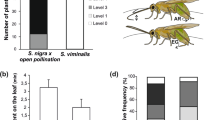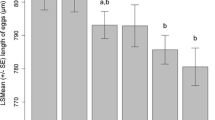Abstract
The recognition by female phytophagous insects of a plant as a ‘good’ or ‘bad’ host for egg laying is based on a variety of cues (either visual, physical or chemical). Specific cues are often looked for during stereotypic oviposition behaviors, composed of several phases having their own function(s). In this study the oviposition behavior of the pollen beetle Meligethes aeneus, a pest which lays eggs in flower buds of only some brassicaceous plants, was described in detail on five oilseed rape (Brassica napus) genotypes. In parallel, setae borne by the ovipositor were characterized by scanning electron microscopy. Observations showed that the stereotypic oviposition sequence is functionally divided into three independent phases: external inspection, internal inspection and egg laying. The ovipositor plays a role in all phases by gaining information about external and internal bud parts. This role appears to be only physical since all the setae it bears are mechanoreceptors. Despite the fact that the pollen beetle is a specialist for oviposition, important variations in secondary metabolites that are typical of its host plant family (i.e., glucosinolates) on the bud did not influence clutch size. The crucial phase in the oviposition sequence seems to be the external inspection, during which poor and high-quality host plants are probably discriminated. Chemical information on bud surface is likely to be determinant in this process.



Similar content being viewed by others
References
Audisio P, Cline AR, De Biase A, Antonini G, Mancini E, Trizzino M, Costantini L, Strika S, Lamanna F, Cerretti P (2009) Preliminary re-examination of genus-level taxonomy of the pollen beetle subfamily Meligethinae (Coleoptera: Nitidulidae). Acta Entomol Musei Nat Pragae 49(2):341–504
Benjamini Y, Hochberg Y (1995) Controlling the false discovery rate: a practical and powerful approach to multiple testing. J R Stat Soc B 57:289–300
Błażejewicz-Zawadziska M, Błażejewski F (2002) Sensory organs of mouth parts of selected species of the genus Meligethes Stephens (Coleoptera: Nitidulidae). Wiadomości Entomologiczne 21(3):137–154
Borg A, Ekbom B (1996) Characteristics of oviposition behaviour of the pollen beetle, Meligethes aeneus on four different host plants. Entomol Expl Appl 81:277–284
Chapman RF (2013) Mechanoreception. In: Simpson SJ, Douglas AE (eds) The Insects: structure and function, 5th edn. Cambridge University Press, New York, pp 738–770
Clissold FJ, Sanson GD, Read J, Simpson SJ (2009) Gross vs. net income: how plant toughness affects performance of an insect herbivore. Ecology 90(12):3393–3405
Cook SM, Murray DA, Williams IH (2004) Do pollen beetles need pollen? The effect of pollen on oviposition, survival, and development of a flower-feeding herbivore. Ecol Entomol 29:164–173
R Core Team (2013) R: A language and environment for statistical computing. R Foundation for Statistical Computing. Vienna, Austria. URL http://www.R-project.org/
Ekbom B (1998) Clutch size and larval performance of pollen beetles on different host plants. Oikos 83(1):56–64
Ekbom B, Borg A (1996) Pollen beetle (Meligethes aeneus) oviposition and feeding preference on different host plant species. Entomol Exp Appl 78:291–299
Ekbom B, Ferdinand V (2003) Field oviposition rates and egg load dynamics of pollen beetles (Meligethes aeneus Fab.) (Coleoptera: Nitidulidae). Agric For Entomol 5:247–252
Fahey JW, Zalcmann AT, Talalay P (2001) The chemical diversity and distribution of glucosinolates and isothiocyanates among plants. Phytochemistry 56:5–51
Ferguson AW, Nevard LM, Clark SJ, Cook SM (2014) Activity-temperature relationships in Meligethes aeneus: implications for pest management. Pest Manag Sci. doi:10.1002/ps.3860
Free JB, Williams IH (1978) The responses of the pollen beetle, Meligethes aeneus, and the seed weevil, Ceutorhynchus assimilis, to oil-seed rape, Brassica napus, and other plants. J Appl Ecol 15(3):761–774
Gripenberg S, Mayhew PJ, Parnell M, Roslin T (2010) A meta-analysis of preference-performance relationships in phytophagous insects. Ecol Lett 13:383–393
Hervé M (2013) SequenceR : une interface d’encodage de séquences comportementales. http://www.maximeherve.com/r-statistiques/sequencer
Hervé MR, Delourme R, Gravot A, Marnet N, Berardocco S, Cortesero AM (2014a) Manipulating feeding stimulation to protect crops against insect pests? J Chem Ecol 40:1220–1231
Hervé MR, Delourme R, Leclair M, Marnet N, Cortesero AM (2014b) How oilseed rape (Brassica napus) genotype influences pollen beetle (Meligethes aeneus) oviposition. Arthropod Plant Interact 8:383–392
Hopkins RJ, Ekbom B (1996) Low oviposition stimuli reduce egg production in the pollen beetle Meligethes aeneus. Physiol Entomol 21:118–122
Hopkins RJ, Ekbom B (1999) The pollen beetle, Meligethes aeneus, changes egg production rate to match host quality. Oecologia 120:274–278
Hopkins RJ, Ekbom B, Henkow L (1998) Glucosinolate content and susceptibility for insect attack of three populations of Sinapis alba. J Chem Ecol 24(7):1203–1216
Hopkins RJ, van Dam NM, van Loon JJA (2009) Role of glucosinolates in insect-plant relationships and multitrophic interactions. Annu Rev Entomol 54:57–83
Kaasik R, Kovács G, Toome M, Metspalu L, Veromann E (2014a) The relative attractiveness of Brassica napus, B. rapa, B. juncea and Sinapis alba to pollen beetles. Bio Control 59:19–28
Kaasik R, Kovács G, Kaart T, Metspalu L, Williams IH, Veromann E (2014b) Meligethes aeneus oviposition preferences, larval parasitism rate and species composition of parasitoids on Brassica nigra, Raphanus sativus and Eruca sativa compared with on Brassica napus. Biol Control 69:65–71
Lancashire PD, Bleiholder H, Vandenboom T, Langeluddeke P, Strauss R, Weber E, Witzenberger A (1991) A uniform decimal code for growth-stages of crops and weeds. Ann Appl Biol 119:561–601
Lenth RV (2013) lsmeans: Least-squares means. R package version 1.10-4. http://CRAN.R-project.org/package=lsmeans
Müller C, Riederer M (2005) Plant surface properties in chemical ecology. J Chem Ecol 31(11):2621–2651
Müller C, Rosenberger C (2006) Different oviposition behaviour in Chrysomelid beetles: characterization of the interface between oviposition secretion and the plant surface. Arthropod Struct Dev 35:197–205
Nilsson C (1987) Yield losses in summer rape caused by pollen beetles (Meligethes spp.). Swed J Agric Res 17:105–111
Nilsson C (1989) The pollen beetle (M. aeneus F.) in winter and spring rape at Alnarp 1976–1978. II. Oviposition. Vaxtskyddsnotiser 52(6):139–144
Singer MC (2000) Reducing ambiguity in describing plant-insect interactions: “preference”, “acceptability” and “electivity”. Ecol Lett 3:159–162
Städler E, Schöni R (1990) Oviposition behavior of the cabbage root fly, Delia radicum (L.), influenced by host plant extracts. J Insect Behav 3(2):195–209
Thompson JN (1988) Evolutionary ecology of the relationship between oviposition preference and performance of offspring in phytophagous insects. Entomol Exp Appl 47:3–14
Ulmer BJ, Dosdall LM (2006) Glucosinolate profile and oviposition behavior in relation to the susceptibilities of Brassicaceae to the cabbage seedpod weevil. Entomol Exp Appl 121:203–213
Veromann E, Metspalu L, Williams IH, Hiiesaar K, Mand M, Kaasik R, Kovács G, Jogar K, Svilponis E, Kivimagi I, Ploomi A, Luik A (2012) Relative attractiveness of Brassica napus, Brassica nigra, Eruca sativa and Raphanus sativus for pollen beetle (Meligethes aeneus) and their potential for use in trap cropping. Arthropod Plant Interact. doi:10.1007/s11829-012-9191-6
Williams IH (2010) The major insect pests of oilseed rape in Europe and their management: an overview. In: Williams IH (ed) Biocontrol-based integrated management of oilseed rape pests. Springer, London, pp 1–43
Acknowledgments
We are very grateful to Jo Le Lannic, Francis Gouttefangeas, Loïc Joanny and Maryline Guilloux-Viry for their help with the SEM and to the UMR IGEPP glasshouse team for taking care of the plants used in this study. Maxime Hervé was supported by a CJS grant from the French National Institute of Agronomical Research.
Author information
Authors and Affiliations
Corresponding author
Rights and permissions
About this article
Cite this article
Hervé, M.R., Garcia, N., Trabalon, M. et al. Oviposition Behavior of the Pollen Beetle (Meligethes aeneus): A Functional Study. J Insect Behav 28, 107–119 (2015). https://doi.org/10.1007/s10905-015-9485-5
Revised:
Accepted:
Published:
Issue Date:
DOI: https://doi.org/10.1007/s10905-015-9485-5




